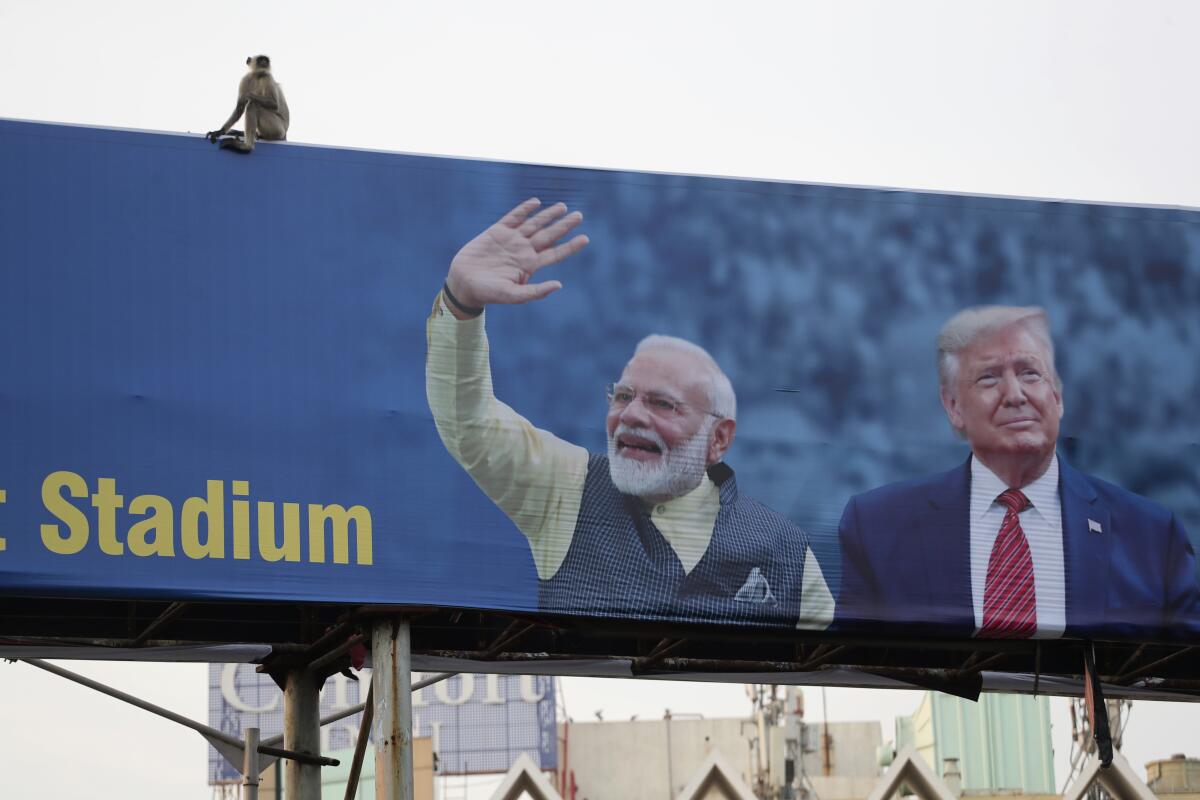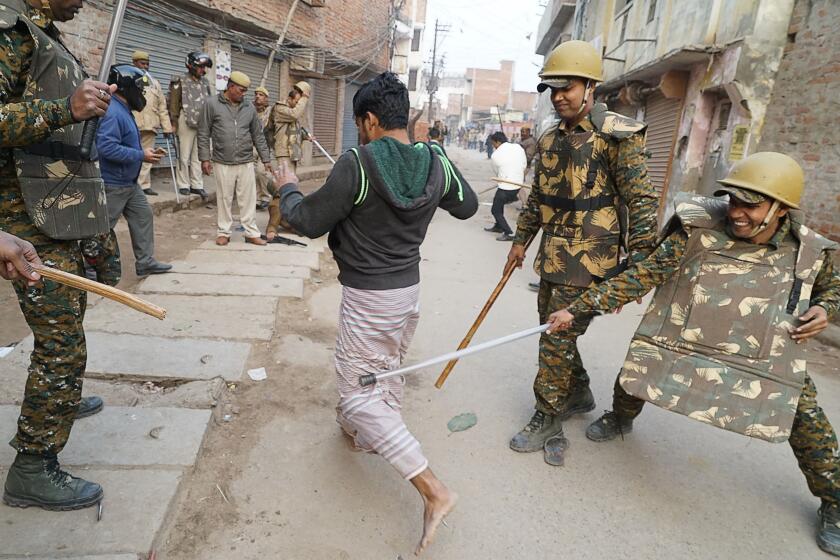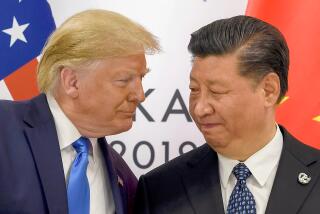Huge rally will highlight Trump’s visit to India

- Share via
NEW DELHI — When presidents go abroad, their trips are typically pre-wired to include a number of “deliverables,” things like trade deals, security agreements and heavily scripted statements by leaders of their affection for one another.
But President Trump’s journey halfway around the world this week is primarily about something else India’s Prime Minister Narendra Modi has promised him — a massive, largely adoring crowd, perhaps the largest he’s ever addressed.
When he steps off Air Force One on Monday in Ahmedabad, a metropolis in the northwestern state of Gujarat that is the birthplace of Modi and Mahatma Gandhi, Trump will motorcade directly to the new Motera Stadium, christening the 110,000-capacity cricket grounds, set to become the world’s largest, with a political rally that will provide Trump the popular adulation he has long sought on the world stage and imagery he can utilize in his reelection campaign.
“It’s going to be very exciting,” Trump crowed last week, saying that Modi has assured him that vast throngs will line the roads. “He says between the stadium and the airport, we’ll have about 7 million people.”
Indian officials countered with a quick reality check, predicting the roadside turnout will be closer to 100,000. Ahmedabad’s entire population is 5.5 million.
Trump, who has canceled trips to Poland, Denmark, Peru, Columbia and Switzerland and is known for wanting to sleep in his own bed whenever possible, will make the 7,472-mile trek to India even though a long-sought bilateral trade agreement, despite hurried efforts in recent weeks, appears nowhere close to consummation.
U.S. exports to India have slowed in recent months, widening the trade deficit, and Modi has turned out to be more protectionist than the White House anticipated, hiking tariffs and customs duties, advancing a personal data-protection bill, e-commerce regulations and taking steps to close some markets. If the two leaders announce progress in some areas, perhaps on medical devices or agricultural products, it could allow them to paper over lingering differences with a marginal step forward.
“There is not quite a trade war between the two countries. It’s more like a trade skirmish,” said Tanvi Madan, a senior fellow at the Brookings Institution in Washington and the author of a new book on how China’s rise has strengthened the U.S.-India alliance.
“Both sides feel the other has changed goalposts, and there are domestic political sensitivities in India to some of the concessions that the Trump administration wants.”
In the absence of a major announcement on trade, Trump and Modi plan to finalize smaller agreements by India to purchase $3.5 billion in defense equipment, including helicopters manufactured by Lockheed Martin and Boeing.
India, Madan said, typically would stay away from the public spectacle of a rally for a visiting politician, especially one in a reelection year, in the interest of avoiding anything that could be construed as an endorsement. Similarly, the public trumpeting of newly signed defense contracts is out of character for the Indian government.
But with Trump, both are seen as necessary concessions.
“You will see them try to roll out the red carpet and ensure that he leaves with a good feeling about India,” Madan said. “It’s not about him, per se, for them. The U.S. relationship for India is crucial as they look at not just the China challenge that’s looming, but also an economic growth slowdown.”
Trump also plans to visit the Taj Mahal in Agra on Monday evening and will take part in a full day of meetings and ceremonial events in New Delhi on Tuesday, as well as a news conference, before returning to Washington.
Ironically, Modi has constructed a government wall for Trump’s arrival — 1,640 feet of bricks, hastily built — to enclose and partially block the president’s passing view of a dismal slum with more than 2,000 residents near the new stadium.
Crews also have been busy picking up trash in Agra, where this week state authorities released water to help flush out the Yamuna River, which runs alongside the Taj Mahal and has long been fouled by algae and pollution.
Whatever his reasons for agreeing to the trip, Trump will be the fourth consecutive U.S. president to visit India, an increasingly important strategic partner given its proximity to economic powerhouse China, nuclear-armed Pakistan and war-plagued Afghanistan.
“The U.S. and India are in greater alignment than they have been in some time,” said Jeff Smith, a research fellow at the Heritage Foundation, a conservative think tank in Washington. He pointed to overlapping strategic objectives, including containing a rising China and opposing its Belt and Road Initiative, curtailing Pakistani-based terrorism and supporting a free and open Indo-Pacific region.
There are several divergences beyond trade, however. India has shown no interest in Trump’s past offers to mediate its decades-old dispute with Pakistan over Kashmir. And the Trump administration’s recent outreach toward Pakistan has rankled some leaders in New Delhi.
In Washington, lawmakers in both parties have criticized India’s controversial Citizenship Amendment Act, which was backed by Modi’s Hindu nationalist Bharatiya Janata Party.
Under the bill, passed by India’s parliament in 2019, citizenship is increasingly based on religion. The government has begun fast-tracking the immigration process for Hindus, Sikhs, Buddhists, Jains, Parsis and Christians while excluding Muslims.
Charges of religious bias by security forces have blighted Prime Minister Narendra Modi’s credentials as leader of the world’s largest democracy.
Although Trump may speak broadly to India’s tradition as the world’s largest democracy, his own approach to immigration, and to Muslims, specifically — he tried to impose a ban on Muslim immigrants less than a week after taking office in 2017, although the order was quickly halted by the courts — means he is unlikely to object to the Indian policy.
“The good news for India is that the last person in the world likely to raise any of these issues is Donald Trump,” said Bruce Riedel, an expert on South Asia and the Middle East at the Brookings Institution. “He’s an Islamophobe himself.”
While Trump does not enjoy warm relationships with the leaders of several longstanding U.S. allies, he and Modi have built something of a personal chemistry on a foundation of their shared protectionism, immigration restrictions and disdain for the free press in their respective countries.
Their joint appearance at last September’s “Howdy, Modi” rally before 50,000 Indian Americans in a Houston arena offered a precursor to Monday’s main event, titled “Namaste, Trump.”
For Trump, the political upside with Indian Americans, who account for just 1% of the U.S. electorate and tend to lean Democratic, is marginal at best. But the broader optics of a president being cheered abroad could help his campaign emphasize foreign policy accomplishments.
The visit may be more beneficial to Modi. His aura of political invincibility has dimmed in recent months amid growing tensions between the Hindu majority and Muslims inflamed by the new citizenship law, which has sparked protests and allegations of excessive force by police looking to quell uprisings in largely Muslim areas.
Modi has also faced international criticism for a months-long clampdown in the disputed, Muslim-majority territory of Kashmir, where political leaders have been placed under house arrest and internet services have been restricted since August — the longest-ever internet shutdown in a democracy.
“Trump’s visit will give a much-needed political boost to Modi,” said Seema Sirohi, a columnist for India’s Economic Times.
Despite opposition to Trump’s trade policies, he is broadly popular in India. Some 56% of Indians said they are confident he will do the right thing in world affairs, according to a recent poll by the Pew Research Center.
Embracing Trump with a lavish welcome gives Modi “diplomatic air cover at a time when his controversial domestic policies have fueled street protests across the country and intensified diplomatic concern abroad,” said Milan Vaishnav, director of the South Asia program at the Carnegie Endowment for International Peace.
For Modi, just getting a visit from Trump is victory enough, analysts said.
“For Trump to get up and go all the way to India … it’s a pretty big deal and a validation for Modi in the face of this withering international criticism,” said Vipin Narang, an associate political science professor at MIT. “There’s a lot of focus on the lack of deliverables, but for Modi, the trip itself is the deliverable.”
Stokols reported from Washington and New Delhi. Bengali reported from Singapore.
More to Read
Get the L.A. Times Politics newsletter
Deeply reported insights into legislation, politics and policy from Sacramento, Washington and beyond. In your inbox three times per week.
You may occasionally receive promotional content from the Los Angeles Times.













